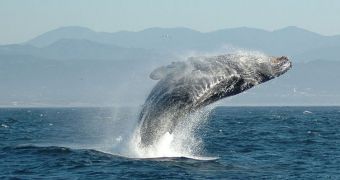The Western North Pacific gray whale population could be severely endangered in the near future, if plans announced by the Sakhalin Energy Investment Company come to fruition. The corporation, which is partially owned by Shell, wants to construct a new drilling rig off Sakhalin Island.
But conservationists say that the area represents a critical feeding habitat for the gray whale groups living throughout the Western North Pacific Ocean. Any interferences with their habits could have a disastrous effect on their numbers.
These creatures are the only surviving member of the genus Eschrichtius, which developed in Oligocene period, more than 30 million years ago. The whales can live for up to 70 years, weigh 36 tonnes, and have a length of 52 feet, or around 16 meters.
Groups of gray whales come to Sakhalin Island every single year, in order to feed. This is the largest island in the Russian Federation, and it is located near the Russo-Japanese border.
The Western population currently features only about 130 whales, and they are critically endangered. Building a polluting oil rig right in the middle of their feeding grounds could wipe them out.
But Shell and SEIC's is not the only endeavor in the area. Multiple oil and gas exploration and development projects are being planned for this region, experts with the World Wildlife Fund say.
“Just around 30 female western gray whales of breeding age remain – the population is already on the brink of disappearing forever,” explains the WWF-Russia Oil & Gas Environmental Policy Officer, Aleksey Knizhnikov.
“The loss of even a few breeding females could mean the end for the population,” he goes on to say, after underlining some of the risks that these whales will be exposed to if the projects get approved.
The construction of new drilling rigs could disrupt feeding behavior, or increase the chances of collisions between whales and various ships. Additionally, the risk of an oil spill increases several times over.
According to the International Union for the Conservation of Nature (IUCN), the Western gray whale population is genetically different from the Eastern one, which means that the two do not mix.
“We are astonished by the announcement from Sakhalin Energy that it intends to build a third platform,” explains WWF-International Species Program Manager, Wendy Elliott.
“The company’s own detailed assessments concluded previously that two platforms would be preferable, both for environmental reasons and for the efficiency of the operation,” she concludes.

 14 DAY TRIAL //
14 DAY TRIAL //